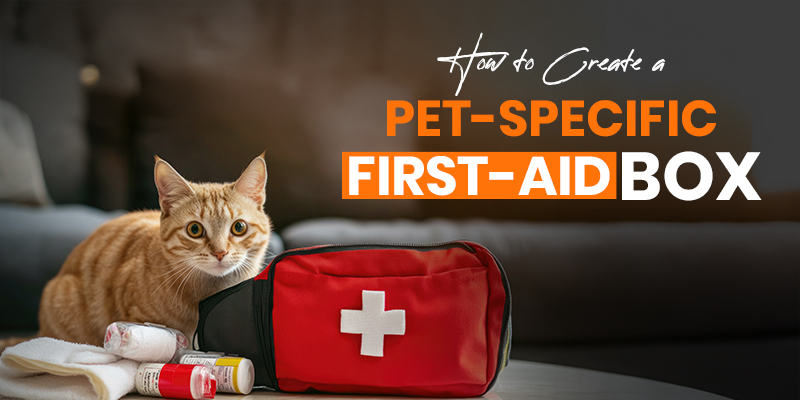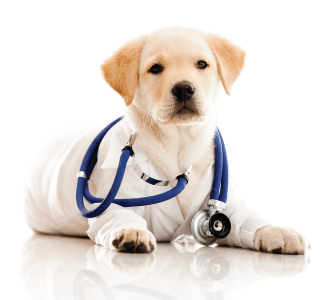
Check out our latest products
Health emergencies don’t come with prior intimation. Therefore, when they strike, it is important that we have a good first-aid kit in place. If you are a new pet parent and wondering what should be inside your furry baby’s first-aid kit, don’t worry, as we are here to help. In this blog, we will take you through the essential supplies that should be a part of your pet’s first-aid kit. Let’s get started!
Contents in a Pet’s First-Aid Kit
Below are the must-have contents in a pet’s first aid kit.
1 Bandages
Bandages are very important in a pet’s first-aid kit. They help you temporarily protect your pet’s wound and prevent infection before you get it checked by a vet. You need to make sure that the bandages are strong enough to stick around for a while, but not so tight as to prevent blood flow.
Essential bandage supplies include:
- Gauze pads and rolls
- Crepe bandages
- Tape
- Tweezers
- Blunt-tipped scissors
- Gloves (latex or rubber)
2. Wound Care Product
If your pet happens to get hurt, using a pet-specific antimicrobial wipe, ointment, and spray is a must to prevent the risk of infection. However, seek your vet’s advice before applying any formula to your pet’s wound at home.
3. Eye Wash
If you suspect that an irritant has gotten into your pet’s eye and is causing irritation, using a pet-specific eye wash may help eliminate the foreign particle and soothe your pal’s eyes. Therefore, make sure to add it to your pet’s first-aid kit. But if the condition worsens and the eye wash doesn’t seem to help, seek immediate medical help.
Read More : Eye Disorders in Pets: Understanding and avoiding them
4. Syringe
A needleless syringe is highly important in your pet’s first-aid kit and can be used in a number of ways. They can be used to administer oral liquid treatments and even flush out and clean wounds.
5. Pet-Specific Cleansing Wipes
Pet-specific cleansing wipes are essential to tackle messy emergencies. They help you clean urine, anal gland secretion, stool and blood that may get discharged during emergencies, without the risk of spreading infection and contamination.
6. Probiotics
Stomach issues are quite common with in dogs and cats. If your furry companion is suffering from diarrhea, vomiting or is reluctant to eat, probiotics can help magically to comfort them. They work excellently to heal their gut and alleviate the symptoms.
7. Pet Thermometer
If you suspect that your pet is feverish, a pet thermometer will help you determine the severity of the fever. A digital thermometer works well to take the pet’s rectal temperature. You may use it by following the directions mentioned on its label or seeking your vet’s assistance. However, if you’re not looking for an invasive device, you can go for an underarm thermometer. It is designed to determine your pet’s temperature by placing it under its front legs. Though this type of thermometer can be expensive, it is surely worth your pet’s comfort.
8. Flea & Tick Treatments
Both dogs and cats are highly vulnerable to flea and tick infestations. Therefore, if you spot these pesky organisms on your pet’s body, it is important that you immediately administer flea and tick treatments at your earliest opportunity to treat and eliminate them.
When it comes to dogs, Frontline Plus for Dogs, Bravecto and NexGard work well to treat flea and tick infestations. While for cats, Advantage Multi, Revolution and Frontline Plus for Cats work excellently to kill and eradicate these parasites.
9. Emergency Contact Information
A contact card with the phone number of your vet, closest veterinary hospitals, 24-hour clinics and pet poison center should always be kept in your pet’s first aid box.
Besides this contact card, you must keep copies of your pal’s medical reports inside the kit. In case of an emergency, run to the veterinarian; these records will be of great help to him.
Maintaining a Pet First Aid Kit
Once you’ve successfully assembled the supplies for your pet’s first aid kit, you’re covered for a few months. However, it is important that you monitor the kit every 6 months and replenish it.
Below are the aspects that you need to take into consideration while checking the first aid kit:
– You will need to go through the expiration dates of all the products and replace them when necessary.
– Inspect items like cleansing wipes to make sure they are in good condition and haven’t dried up.
– Check the batteries of any devices and replace them if required.
– Update your pet’s medical records.
Wrapping Up
Building a first aid kit for your pet and keeping it accessible is an efficient way to ensure your pet’s safety at home. Be it minor injuries or accidents, the kit keeps you equipped to tackle emergencies.
At CanadaVetCare, we carry a wide range of treatments and pet essentials at the best prices. Visit our online store today to enjoy lucrative deals on the products of your choice from the comfort of your home.

David joined CanadaVetCare in 2013 as a product analyst and veterinary assistant. Being a passionate pet lover and keen animal health researcher, David had always found ways and solutions to help pet parents to improve their pets’ health. He is always happy to answer pet health-related queries and recommending pet parents for the right pet product for their furry companions.







![[5G & 2.4G] 2K Indoor Security Camera for Home Security, AI Voice Change for 2-Way Talk, Motion Detection, Night Vision, 24/7 SD Recording/Cloud Storage, WiFi Home Camera, Pet Cam with Phone App](https://i3.wp.com/m.media-amazon.com/images/I/61I2U+sTT3L._AC_SL1500_.jpg?w=300&resize=300,300&ssl=1)






